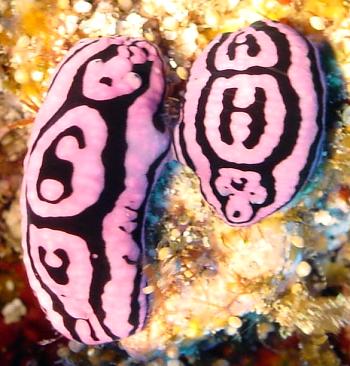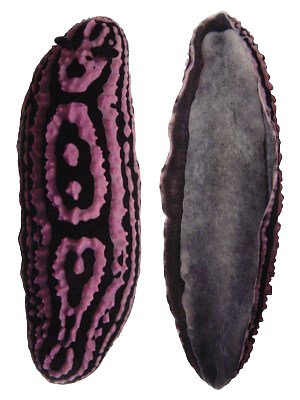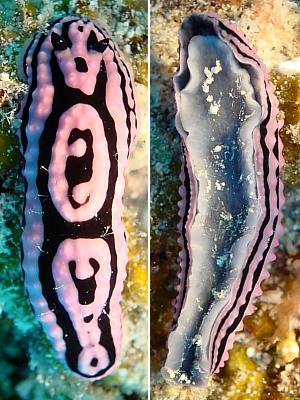
Phyllidiella meandrina
(Pruvot-Fol, 1957)
Order: NUDIBRANCHIA
Suborder: DORIDINA
Superfamily: EUDORIDOIDEA
Family: Phyllidiidae
DISTRIBUTION
Indian Ocean
PHOTO
Upper Right: October 07, 2002. ‘Le platier de la Pointe au Sel’, St-Leu, Reunion Island, Indian Ocean. 40-45mm at 21m. Lower Left: October 06, 2002. ‘Maison Verte’, St-Leu, Reunion Island, Indian Ocean, 50-55mm at 14m. Lower Right: October 16, 2002, ‘Grand Aquarium’, Pereybere, Mauritius, Indian Ocean, 45-50mm at 10m. Photos: Marina Poddubetskaia
P. meandrina is black with pink tubercles. There is a pink band around the mantle edge and inside that there are two tuberculate ridges which encircle the mantle, the outer one being quite narrow and the inner much broader. Down the central part of the mantle the arrangement of the pink tubercles is very characteristic. At the anterior end there are two joined pink rings forming an irregular 'figure of 8' between the rhinophores. The ring behind the rhinophores is larger than the one on front. Behind these rhinophoral rings is a large elongate ring, which has two isolated pink tubercles in the black central region. Behind this ring is another elongate ring with one isolated central tubercle. From the posterior end of this ring is a narrow double ridge running back to join a smaller ring which apparently surrounds the anal papilla. In some animals the ridges are quite sharply tuberculate while in others the tubercles are low giving the ridges are smooth appearance. Another area of variation is the degree of isolation of the tubercles in the centre of the rings. In some specimens they are isolated, while in other specimens they are connected to the surrounding ring by a short ridge. The rhinophores are black, and the underside of the mantle and the foot are a blackish grey. It is probable that the animals I have been calling Phyllidiella cf. annulata, from Christmas Island in the eastern Indian Ocean, which have a pale border to the mantle edge and only one ridge outside the median rings, is a form of P. sudanensis.
Phyllidiella meandrina has similarities to Phyllidiella annulata in having a pattern of rings on the mantle, and to Phyllidiella zeylanica in the arrangement of ridges and the ring of tubercles around the anus. At our present understanding of the species, these animals fit neither species well. In particular, P. annulata has a central row of 4 rings and an outer band of smaller rings. Around the mantle edge are small pink tubercles, and there is no continuous pink edge to the mantle. Although I have no anatomical information, the external shape and colour would suggest that this is a species of Phyllidiella rather than Phyllidia, as redefined by Brunckhorst (1993). I am surprised that Fahrner & Beck (2000) and Fahrner & Schroedl (2000) didn't find this species in their recent reviews of the family.
Brunckhorst (1998) incorrectly considered P. meandrina and its synonym, P. sudanensis (Heller & Thompson, 1983) to be an aberrant specimens of P. annulata. See also Phyllidiella cf. annulata, from the eastern Indian Ocean, which has a pale border to the mantle edge and one pink ridge encircling the mantle, is most probably a form of P. meandrina. See message discussing the identity of this species. P. meandrina was previously identified on the Forum as Phyllidiella cf. zeylanica.
References:
• Brunckhorst, D.J. (1993) The systematics and phylogeny of Phyllidiid Nudibranchs (Doridoidea). Records of the Australian Museum, Supplement 16: 1-107.
• Fahrner, A. & Beck, L.A. (2000) Identification key to the Indo-Pacific species of the nudibranch family Phyllidiidae Rafinesque, 1814, including the description of two new species (Gastropoda: Opisthobranchia). Arch. Molluskenkd., 128: 189-211.
• Fahrner, A. & Schroedl, M. (2000) Redescription of Phyllidiopsis sinaiensis (Yonow, 1988) (Nudibranchia: Phyllidiidae), with a review of the Red Sea Phyllidiidae. J. Moll. Stud., 66: 467-476.
• Heller, J. & Thompson, T.E. (1983) Opisthobranch molluscs of the Sudanese Red Sea. Zoological Journal of the Linnean Society, 78(4): 317-348.
• Pruvot-Fol, A. (1957) Revision de la famille des Phyllidiadae. 2. Journal de Conchyliologie, 97: 104-135, Pl.1.
• Yonow, N. (1986) Red Sea Phyllidiidae (Mollusca: Nudibranchia) with descriptions of new species. Journal of Natural History, 20(6): 1401-1428.
• Yonow, N. & Hayward, P.J. (1991) Opisthobranches de l'Ile Maurice, avec la description de deux especes nouvelles (Mollusca: Opisthobranchia). Revue francaise d'aquariologie, 18(1): 1-30, Figs 1-13.
• Yonow, N., Anderson, R.C. & Buttress, S.G. (2002) Opisthobranch molluscs from the Chagos Archipelago, Central Indian Ocean. Journal of Natural History, 36(7): 831-882


Rudman, W.B., 2002 (November 5) Phyllidiella meandrina (Pruvot-Fol, 1957). [In] Sea Slug Forum. Australian Museum, Sydney. Available from http://www.seaslugforum.net/factsheet/phylmean
Related messages
-
Re: Phyllidiella meandrina from Indian Ocean [2]
From: Hugues Flodrops, November 28, 2006 -
Re: Phyllidiella meandrina from Indian Ocean [1]
From: Hugues Flodrops, November 28, 2006 -
Phyllidiella meandrina feeding ?
From: Marina Poddubetskaia, November 28, 2003 -
Re: Phyllidiella meandrina
From: Bill Rudman, November 28, 2002 -
Phyllidiella meandrina from Indian Ocean [1]
From: Marina Poddubetskaia, November 8, 2002 -
Phyllidiella meandrina from Indian Ocean [2]
From: Marina Poddubetskaia, November 8, 2002 -
Rediscovery of Phyllidiella meandrina
From: Bill Rudman, November 8, 2002 -
More on Phyllidiella pustulosa? from Mauritius
From: Erwin Koehler, September 14, 1999 -
Phyllidiella annulata? from Mauritius
From: Erwin Koehler, September 13, 1999
